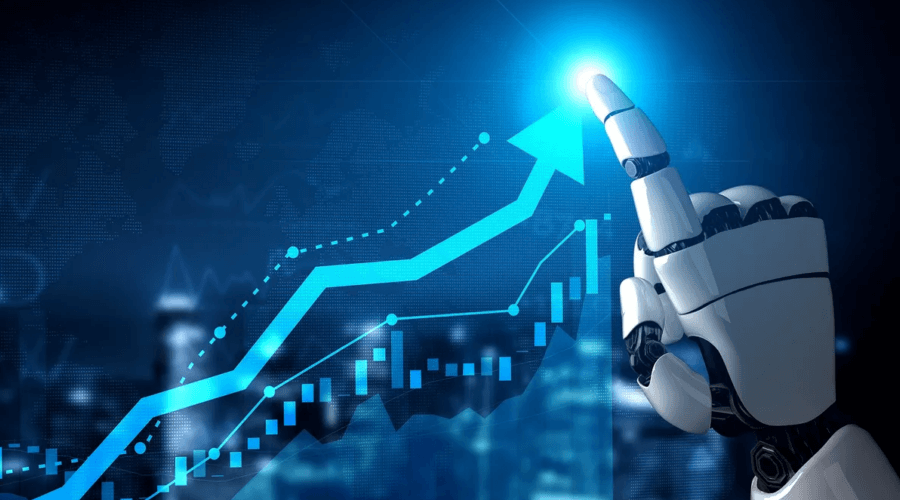In 2025, the financial world is witnessing a revolution. The rise of AI trading—powered by advanced algorithms, big data, and artificial intelligence investing—is reshaping the way investors, brokers, and hedge funds operate. What was once dominated by human intuition and experience is now enhanced by intelligent machines capable of making lightning-fast, data-driven decisions.
This shift is not just a technological upgrade; it’s a complete transformation of global stock market trends. From risk assessment to predictive analytics, artificial intelligence is taking the stock market to unprecedented levels of precision and efficiency. Let’s explore how AI-driven trading is redefining finance and what it means for investors in 2025 and beyond.
1. The Evolution of AI in Trading
Artificial intelligence investing didn’t happen overnight. The first algorithmic trading systems emerged in the early 2000s, automating simple buy and sell orders. Today, AI-driven systems analyze massive datasets, detect hidden patterns, and make split-second trades—all without emotional bias.
According to Goldman Sachs, over 70% of stock trades in the U.S. are now executed by algorithms, and the number continues to grow as AI models become more sophisticated. Machine learning enables these systems to improve autonomously, learning from every market movement.
For example, BlackRock’s Aladdin platform leverages AI to manage over $10 trillion in assets by analyzing risks, forecasting returns, and optimizing portfolios. Similarly, retail trading platforms like eToro and Robinhood now incorporate AI-driven insights to assist everyday investors.
Pro Tip: The key to success with AI trading lies in data quality—AI is only as good as the information it processes.
2. How AI Analyzes Data and Predicts Market Movements
AI trading systems thrive on one thing—data. Unlike humans, who can analyze a few charts and indicators, AI can process millions of data points per second. These systems scan historical prices, news sentiment, economic data, and even social media trends to identify profitable opportunities.
Machine learning models such as neural networks and reinforcement learning algorithms enable AI to recognize correlations invisible to traditional analysts. For instance, algorithms can detect how geopolitical events, interest rate changes, or consumer sentiment might influence stock movements before humans can react.
Companies like Kavout use AI-based scoring systems that evaluate over 5,000 global equities daily, giving investors AI-powered ratings to guide trading decisions. Likewise, Refinitiv offers AI tools for sentiment analysis and real-time risk monitoring.
Pro Tip: AI models can adapt to changing stock market trends faster than traditional systems, making them invaluable in volatile markets.
3. AI Trading vs. Traditional Human Trading
In the past, human traders relied on intuition, experience, and emotional judgment. While valuable, these human traits also introduced errors—fear, greed, and bias often clouded decision-making. AI trading, on the other hand, operates purely on logic and data.
AI-driven systems don’t tire, panic, or make impulsive trades. They can process vast amounts of information instantly and execute trades based on probabilities rather than emotions. For example, hedge funds like Two Sigma and Citadel employ AI to predict stock performance using sophisticated statistical models.
However, AI is not infallible. It can misinterpret anomalies, overfit data, or amplify market volatility during extreme events. That’s why many financial institutions use a hybrid approach—AI-driven automation combined with human oversight.
Internal link suggestion: For more insight into automation’s role in modern systems, explore AI Tools for Entrepreneurs: Boost Productivity in 2025.
Pro Tip: Successful traders integrate human intuition with AI precision, creating a powerful synergy between man and machine.
4. The Rise of Retail AI Investing
Previously, AI trading was limited to institutional investors. But in 2025, retail traders have unprecedented access to artificial intelligence tools. Platforms like TradeStation and QuantConnect allow individuals to use algorithmic models to build and backtest trading strategies without needing advanced coding knowledge.
Robo-advisors, such as Betterment and Wealthfront, use AI to manage investment portfolios automatically, optimizing asset allocation and rebalancing based on risk tolerance and market data.
This democratization of AI investing has led to a boom in smart investing apps. According to Statista, the global robo-advisory market is expected to exceed $3 trillion by 2026, growing rapidly as consumers trust AI with their wealth.
Pro Tip: Even small investors can now harness AI for better returns—no Wall Street background required.
5. Predictive Analytics and Risk Management
One of the greatest advantages of AI trading is predictive analytics. AI can forecast potential market movements using real-time and historical data, helping traders anticipate risks before they occur. This predictive ability enables better hedging, portfolio diversification, and volatility management.
Financial firms like J.P. Morgan use AI tools to model “what-if” scenarios and simulate market crashes to safeguard investments. Similarly, startups like Dataminr use real-time AI alerts to warn traders about global events that could affect market prices.
These models continuously refine themselves. Each trade or market event becomes part of the AI’s learning process, making future predictions increasingly accurate over time.
Pro Tip: Investors using AI-powered predictive tools can reduce portfolio volatility by as much as 30% compared to manual trading strategies.
6. AI and Ethical Investing
AI isn’t just making trading smarter—it’s making it more ethical. In 2025, many investors are aligning their portfolios with sustainability goals through artificial intelligence investing. AI tools analyze ESG (Environmental, Social, and Governance) data to identify companies that align with ethical values.
Platforms like MSCI ESG Ratings and Refinitiv ESG use machine learning to evaluate corporate sustainability, diversity, and governance standards. This ensures investors can support ethical companies without compromising financial performance.
Internal link suggestion: To explore more sustainability innovations, visit Net-Zero Homes: The Future of Sustainable Living.
Pro Tip: AI-driven ethical investing isn’t just a trend—it’s the future of responsible wealth building.
7. The Future of Stock Market Trends with AI
As AI trading matures, the stock market trends of 2025 reveal an increasingly interconnected ecosystem. AI is now being integrated with quantum computing, blockchain, and predictive analytics, allowing for faster and more secure transactions.
For instance, IBM Quantum is working on next-generation computing systems capable of analyzing billions of data points per second. Combined with blockchain transparency, this could eliminate insider trading and fraud by ensuring all transactions are traceable and verifiable.
Moreover, AI will continue to enhance financial inclusion. With mobile AI trading apps expanding globally, millions of people in developing countries can now access international markets with minimal fees.
Pro Tip: The next wave of AI innovation will focus on explainability—helping traders understand why AI makes certain decisions, not just what it predicts.
8. Risks and Challenges of AI Trading
While the benefits are enormous, AI trading also presents challenges. Algorithmic errors, flash crashes, and overreliance on data models can cause sudden market disruptions. The 2010 “Flash Crash,” though pre-AI, foreshadowed how automated trading can spiral if not properly regulated.
To mitigate such risks, regulatory bodies like the U.S. Securities and Exchange Commission (SEC) and FINRA are introducing stricter AI compliance standards. Transparency, ethical design, and human oversight remain crucial components of any AI-based financial system.
Pro Tip: Investors should choose AI platforms that provide transparent algorithms and real-time monitoring tools to reduce the risk of system errors.
Final Thoughts: The Intelligent Future of Finance
The rise of AI trading in 2025 is more than a financial innovation—it’s a paradigm shift. The integration of artificial intelligence investing is making markets faster, fairer, and more data-driven than ever before. With advanced analytics, predictive algorithms, and accessible AI tools, the playing field between retail and institutional investors is beginning to level.
Yet, as intelligent as machines become, human strategy still matters. The future of finance will rely on a partnership between human creativity and machine precision—a collaboration that defines the next era of stock market trends.
For more insights on the role of technology in modern innovation, explore Future Tech: 10 Emerging Innovations Changing the World.




